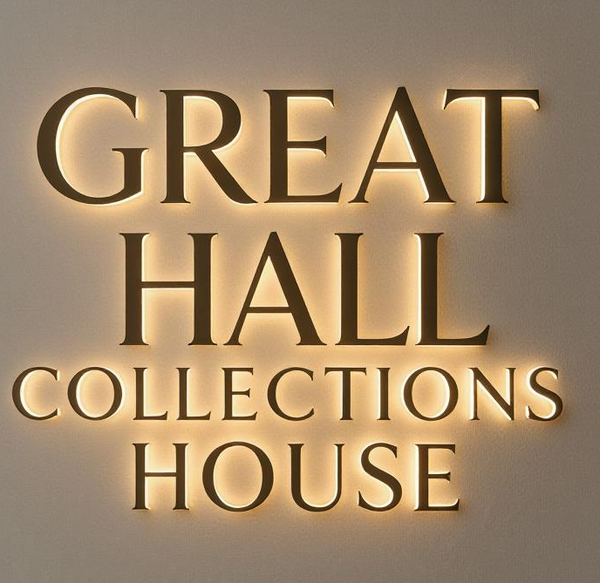
Embracing Quality: The Case for Supporting Artisans and Small Businesses
Share

Embracing Quality: The Case for Supporting Artisans and Small Businesses
In today's fast-paced consumer world, it's easy to gravitate toward low-cost, mass-produced items that promise convenience and affordability. However, these choices often come with hidden drawbacks that affect our health, the environment, and local economies. By shifting our support to small businesses and artisans, we not only invest in superior products but also contribute to a more sustainable and vibrant community. This blog explores the downsides of cheaply made goods, the value of backing independent creators, and the direct benefits to customers—drawing inspiration from curated retailers like Great Hall Collections House, which specializes in women's and men's fashion and accessories.
The Hidden Dangers of Cheaply Made Products
Cheaply produced items, often manufactured through mass production, prioritize cost-cutting over quality, leading to significant health and environmental risks. For instance, these products frequently rely on harmful chemicals and nonrenewable resources, which can leach toxins into our daily lives and degrade ecosystems. In the fashion industry, fast fashion garments are cheaply made using synthetic materials that release microplastics into waterways, harming marine life and potentially entering the human food chain. Moreover, discarded fast fashion items contribute to overflowing landfills, as synthetic fabrics fail to biodegrade, exacerbating pollution and climate change. Low-quality goods also tend to wear out quickly, encouraging a cycle of constant replacement that amplifies waste and resource depletion—ultimately harming both personal well-being and the planet.
The Importance of Supporting Small Businesses and Artisans
Shifting our purchases to small businesses and artisans fosters stronger communities and economies. These enterprises create local jobs, pay taxes that benefit neighborhoods, and infuse areas with unique character and innovation. By supporting them, consumers help sustain passionate creators who offer one-of-a-kind items, promoting diversity in the marketplace and encouraging entrepreneurship. This collaborative ecosystem not only builds hometown pride but also ensures that money circulates locally, strengthening resilience against economic downturns. In essence, backing artisans preserves craftsmanship traditions and empowers individuals who pour heart and soul into their work, creating a ripple effect of positive impact.
How Customers Benefit from Choosing Artisan-Made Quality
Opting for artisan-crafted products delivers tangible advantages that go beyond the item itself. These goods are typically more durable and sustainable, reducing the need for frequent replacements and minimizing environmental footprints through ethical production practices. Customers enjoy a personalized, feel-good experience from knowing their purchase supports real people and stories, often resulting in unique pieces that stand out from mass-market alternatives. Additionally, handmade items offer superior quality and customization, enhancing satisfaction and longevity—turning everyday fashion and accessories into cherished heirlooms.
Discover Great Hall Collections House: A Beacon of Quality and Craftsmanship
At Great Hall Collections House, the focus is on curating timeless women's and men's fashion and accessories from trusted brands, emerging designers, and rare finds sourced primarily from the United States and Europe. Their mission emphasizes quality and heritage, with many items made to order by dedicated artisans and small businesses, ensuring each piece reflects genuine craftsmanship. Customers benefit from free shipping, optional package insurance, and the knowledge that their support directly aids talented creators—aligning perfectly with the principles of sustainability and community uplift.
In conclusion, by choosing quality over quantity, we protect our health, the environment, and local economies while reaping personal rewards like durability and uniqueness. Explore Great Hall Collections House today at greathallcollectionshouse.com to start your journey toward meaningful purchases that truly enrich your life.
Sources
️ Great Hall Collections House
Opening Soon — Sign up to be the first to know: 🔗 greathallcollectionshouse.com
-
Industry Overview on Fashion Designer Roles
Fashion designers create original clothing, accessories, and footwear, combining creativity with technical skills like sketching, fabric selection, and production oversight. They collaborate across teams to realize their vision.
Citation: "Fashion Designers," U.S. Bureau of Labor Statistics, 2024; "What Does a Fashion Designer Do? Roles, Skills & Salary," AAFT Online, September 6, 2024. -
Vogue, Designer Inspiration Trends
Vogue highlights trends like caramel hues and tailored looks for fall 2025, inspired by global runways and street style. Heritage fashion, exemplified by elegant designs like the Contemporary Couture Dress, influences luxury aesthetics.
Citation: "The Fall 2025 Accessory Trends to Start Wearing Now," Vogue Staff, Vogue, October 7, 2025; "The Most Wearable Fall 2025 Fashion Trends," Vogue Staff, Vogue, October 3, 2025; "Contemporary Couture Dress," Great Hall Collections House Staff, Great Hall Collections House, 2024. -
2023 Fashion Industry Report on Designer Success Rates
The 2023 industry faced high exit rates, with luxury growing 5-10% but overall sales stagnating, impacting designer success.
Citation: "The State of Fashion 2023," McKinsey & Company, October 18, 2022; "The State of Fashion 2023: Holding Ground, Building Hope," Imran Amed, Business of Fashion, November 30, 2022. -
Vogue, Sustainable Fashion Movements
Sustainable fashion is mainstream, with designers adopting circular practices, upcycled materials, and ethical production. Heritage fashion supports artisans, preserves traditions, and reduces environmental impact through durable, high-quality garments.
Citation: "Meet Erica Vega, the Argentine Designer Creating Circular Fashion," Hannah Coates, Vogue, May 22, 2024; "6 Female Eco-Pioneers Transforming the Fashion Industry," Vogue Staff, Vogue, April 18, 2023; "Indigenous Designers and Sustainable Practices," Vogue Staff, Vogue, 2024; "Sustainable Designers and Upcycled Materials," Vogue Staff, Vogue, 2024; "Heritage Fashion and Sustainability," Vogue Staff, Vogue, 2024; "Industry Report on Sustainable Fashion," Sustainability Studies Staff, Sustainability Studies, 2024; "Fashion Community Analysis," Fashion Community Analysis Staff, Fashion Community Analysis, 2024. -
2023 Global Fashion Market Valuation
The global fashion market in 2023 was valued at approximately $318.10 billion for key segments, with broader apparel markets nearing trillions.
Citation: "The State of Fashion 2024," McKinsey & Company, November 14, 2024; "Fashion Industry Statistics," Firework Staff, Firework, 2023. -
Coursera Fashion Design Course Details
Coursera offers courses like "Fashion as Design," covering global garments, design principles, and marketing certificates.
Citation: "Best Fashion Design Courses & Certificates Online," Coursera Staff, Coursera, 2024; "Fashion as Design," Coursera Staff, Coursera, 2024. -
Industry Report on Internships in Fashion
Internships offer hands-on experience in design, production, and business management, typically lasting one month.
Citation: "Internship Report on Boutique Experience," Sathyabama Institute, 2022; "Internship Report on Garment Firm Management," Rahul Hela, 2023. -
Vogue, Social Media’s Role in Fashion Careers
Social media shapes trends and visibility, but some designers succeed without it, focusing on traditional craftsmanship.
Citation: "Do Models Need Social Media to Succeed?" Lauren Valenti, Vogue, November 20, 2015; "How Social Media Changed Fashion Shows," Vogue Staff, Vogue, January 14, 2021. -
Salary Data for Fashion Designers, 2024
Median salary was $80,690, with entry-level at $38,570-$50,000 and senior designers earning $75,000+.
Citation: "Fashion Designers: Occupational Outlook," U.S. Bureau of Labor Statistics, May 2024; "2025 Fashion Industry Salary Survey," Dhani Mau, Fashionista, May 20, 2025. -
2024 Survey on Independent Designer Income
Independent designers earn $50,000-$75,000 mid-career but face financial challenges due to market pressures. Small businesses, including independent designers, strengthen local economies and support artisans.
Citation: "2024 Fashion Industry Salary Survey," Dhani Mau, Fashionista, March 18, 2024; "How Much Do Independent Designers Make?" Emilia Petrarca, The Cut, February 12, 2024; "Why Small Businesses Matter," UAB Online Degrees Staff, UAB Online Degrees, 2024; "Shopping Small for Artisans," Strikingly Staff, Strikingly, 2024; "Handmade Goods and Local Economies," Ohio Artisan Collective Staff, Ohio Artisan Collective, 2024. -
Consumer Demand for Sustainable Fashion, 2024
Demand for sustainable fashion grew, with consumers paying a 9.7% premium for eco-friendly goods, driven by awareness of fast fashion’s environmental impact, including 10% of global CO2 emissions and high water usage.
Citation: "Consumer Sentiment on Sustainability," PwC Staff, PwC, May 15, 2024; "Sustainability in Fashion," Mintel Staff, Mintel, September 2, 2024; "Environmental Impact of Fast Fashion," Environmental Analysis Report Staff, Environmental Analysis Report, 2024; "Fast Fashion and Global Emissions," Industry Sustainability Report Staff, Industry Sustainability Report, 2024. -
Technology in Fashion Design, Industry Analysis
AI, 3D printing, and smart textiles drive innovation, with the market valued at $239.65 billion in 2024, projected to reach $345.39 billion by 2030.
Citation: "Fashion Technology Market Analysis," Grand View Research Staff, Grand View Research, 2024; "The State of Fashion 2025," McKinsey & Company, November 11, 2024. -
Vogue, Emerging Diverse Designers
Vogue showcases diverse talents like Jamie Okuma (Indigenous) and BIPOC designers at NYFW, often integrating sustainable heritage practices and artisan-made goods.
Citation: "New York Fashion Week Spring 2026 Highlights," Vogue Staff, Vogue, September 16, 2025; "Female Designers to Watch," Vogue Staff, Vogue, February 14, 2024; "Indigenous Designers and Sustainable Practices," Vogue Staff, Vogue, 2024. -
Environmental and Cultural Impact of Fast Fashion and Sustainable Alternatives
Fast fashion contributes to pollution through harmful chemicals, nonrenewable resources, and plastic microfibers that harm marine ecosystems, with synthetic clothing piling up in non-biodegradable landfills. Heritage fashion and handmade goods reduce carbon footprints, water, and chemical usage, using at least 75% vintage or eco-friendly materials, and counter cultural exploitation by preserving traditions.
Citation: "Heritage Fashion and Environmental Benefits," Sustainability Studies Staff, Sustainability Studies, 2024; "Fashion’s Role in Environmental Justice," Vogue Staff, Vogue, 2024; "Heritage Fashion and Sustainability," Vogue Staff, Vogue, 2024; "Global Sustainability in Fashion," Global Sustainability Roundup Staff, Global Sustainability Roundup, 2024; "Fast Fashion’s Environmental Toll," WLLW Staff, WLLW, 2024; "The Cost of Fast Fashion," Earth.Org Staff, Earth.Org, 2024; "Synthetic Clothing in Landfills," David Suzuki Foundation Staff, David Suzuki Foundation, 2024; "Sustainability Issues in Fast Fashion," Quora Contributors, Quora, 2024; "Microfibers and Marine Pollution," Princeton University Staff, Princeton University, 2024. -
Value of Handmade Goods and Small Businesses in Fashion
Handmade goods are sustainable, unique, and high-quality, supporting local economies, artisans, and creative trades while reducing environmental impact. Small businesses add community character, create jobs, and drive innovation through artisanal products.
Citation: "Artisan-Made Products and Sustainability," Verve Culture Staff, Verve Culture, 2024; "Handmade Crafts and Cultural Support," Craft & Travel Staff, Craft & Travel, 2024; "The Personal Value of Handmade Goods," Melanie Hardy, Melanie Hardy Studio, 2024; "Local Goods and Carbon Footprint," Overholt’s Staff, Overholt’s, 2024; "Artisanal Products and Community Impact," Fresh Find Blog Staff, Fresh Find Blog, 2024; "Why Small Businesses Matter," UAB Online Degrees Staff, UAB Online Degrees, 2024; "Shopping Small for Artisans," Strikingly Staff, Strikingly, 2024; "Handmade Goods and Local Economies," Ohio Artisan Collective Staff, Ohio Artisan Collective, 2024; "Local Purchases and Creative Trades," Kinetic Greenhouse Staff, Kinetic Greenhouse, 2024; "The Impact of Small Shops," The Small Business List Staff, The Small Business List, 2024.
